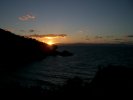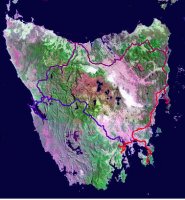
Didn't do much in Hobart besides taking the almost default tour of the Cadbury factory (which was duller than I expected) followed by a short harbour lunch cruise (where the most interesting bit was watching standing waves in the water glass caused by the engine vibrations of the rather old ship).
Picked up the car in the afternoon and drove up to Mount Wellington, partly for the view, partly to get accustomed to the car. It turned out to be a bit windy at the top, but the view as nice. I had a short moment of irritation when I noticed the sign right next to my car and the car didn't start, but on the second try it worked fine and I drove back to Hobart. During the day in Hobart the weather didn't look promising, especially since I was heading 'out to the country' the next day, but as evening came around the clouds just rolled away like a curtain and the weather was fine for the rest of the trip.
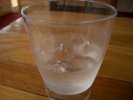

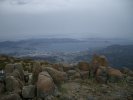
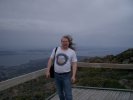
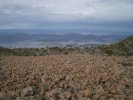
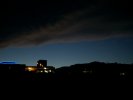
The obvious first destination from Hobart is Port Arthur. Usually I find historic sites pretty boring, but there were some interesting bits on the way and it's a bit of a 'default' destination, so I went there anyway.
The Port Arthur historical site (which was a prison camp) is located on a peninsula which has a very small connection to the mainland. The smallest part is just a hundred meters wide, so it could easily be closed off and watched. (Actually they put a line of dogs across the isthmus). The peninsula itself has an impressive rocky coastline with cliffs and waves of clear blue water smashing into them.
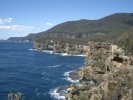



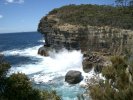

The historic site itself was rather unexpected. Instead of 'gloom and doom', dark buildings, thick walls and a creepy horror movie atmosphere, the former prison site seems - pleasant. And very british. A large ornate garden, a couple of neat cottages and houses for the officers and civilians, a church, a harbour, a library for the prisoners. Somewhat cosy. I know that it was probably hell on earth for those people convicted to go there, but the whole place gives the impression that someone made an effort and really tried to make it a modern facility, following the best knowledge of that time. Some of it looks surprisingly modern. There's a 'building of silence' where they tried to stop flogging as punishment and tried psychological methods instead, like solitary confinement, and 'de-personalization' of prisoners, where they were not allowed to speak, could only walk around in public wearing a canvas bag over the head and were no longer addressed by name, but by number. ("I'm not a number, I'm a free man" and various other "Number Six" references creep into the mind...) And the building for those prisoners had a number of small cells and each one had a little metal flag outside the door with a number on it, which could be raised by then prisoner when he needed to contact the wardens. All in all it seemed like a cosy sort of punishment. (Given a fast internet connection, you could probably lock me up in one of those cells and I wouldn't even notice...)
The visitors center also did a very good job of keeping the place interesting. When you bought a ticket, you were automatically scheduled for a short boat trip through the harbour and a short guided tour. You also got some random playing card. Normally historic exhibitions are boring. There is nothing to do (unlike science exhibits) and it's just some artefacts, old pictures and long texts, so you just walk along, read the headlines and the first couple of lines and wonder why, if you're just looking and reading, you can't just buy the book and do it at home. While it's still basically looking and reading at Port Arthur, it's also a bit of following a thread and that makes it, surprisingly, much more interesting. The playing card represents a convict at Port Arthur, so instead of reading about the various convicts and their fates, you got one 'special' person you want to find out more about, so instead of gazing with equal boredom at all the lifestories, it's one you follow with interest. From there you can spread out to other stories. ('My' convict had a pretty dull life, so I tried to find out which playing card would have given me a more interesting story.) But at least there's something to get you started, which is something I found to be a very clever idea. A similar principle applies to the guided tour. I've seen some guided tours that try to cover everything, which means you start to mentally tune out after a while. The tours at Port Arthur operate similar to the playing card idea for the exhibition. Instead of trying to walk you past everything, it's just a thirty minute walk which gives you some basic overview of the place and some short highlights about the various buildings. So you get a couple of interesting bits and then you can go on and explore on your own.
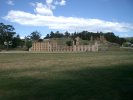


I have no idea whether the harbour cruise is usually presented in a similar way. (Although it's unlikely, since you can't explore on your own.) When I was there, the tour was a bit unusual. Because, when looking at the site, the clouds in the background looked kind of odd.
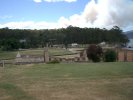
And while later it was quite obvious that these clouds had nothing to do with the weather.
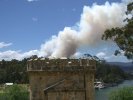
By the time the cruise was about to start, it was obvious that a full scale bushfire was raging just a couple of kilometers away. Which, for a moment, got me thinking about being on a peninsula with just one street leading back to the mainland and the position of the fire relative to it. But while the fire was just about two hundred meters from the street, the wind was blowing away from the street, so there wasn't any problem. But the fire was spreading towards a bay, so the ship made a detour to that bay, so everyone could get a good look and nice horrible pictures.

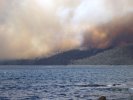
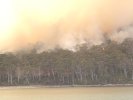
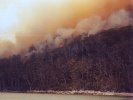

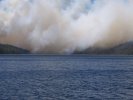
After the bushfire it sort of turned slightly surreal. I was walking through the formal gardens when some christmas music could be heard from nearby. I followed the sound and found some school orchestra from Ulverstone practising in the ruins of the prison church. (As far as I gathered they had some deal with the visitor center. The orchestra would play for a certain amount of time in the church and in exchange they wouldn't have to pay the entrance fee for the site.) So I ended up standing in a ruin of a church, in the middle of a well kept garden, right in a historic prison site, on a warm sunny day in mid-December, listening to a school orchestra, playing christmas songs while looking over a pleasant bay, with a burning forest as backdrop. Somehow it all didn't quite fit and overall it was a fairly strange feeling. (In between christmas standards like "Rudolph the red nosed reindeer" they were also playing songs like "Tequila", which made me wonder a bit what kinds of christmas parties they have in Tasmania...)

I did a little detour to Remarkable Cave, which not many people seem to do (as you can tell from the utterly deserted parking lot), even though it's quite close to the Port Arthur historic site and has a nice coastline to go with it. And while that's not the reason for its name, it is remarkable that the walls of the cave, together with the coastline behind it, more or less form the outline of Tasmania.
But while I'm writing about a detour, I may as well have a little detour in writing, caused by the name "Remarkable Cave". What kind of name is that? There are a number of places in Tasmania where whoever named those had run out of imagination (and the name of friends, relatives or royalty back home). "Cloudy Bay"? "Bushy Park"? (At least with names like "Bay of Fires", "Friendly Beaches" or "Trousers Point" you start to wonder what story may be behind that name.) The 'running out of suitable names' seems even worse in New Zealand, which has such places as "Bay of Islands", "Blue Lake" (twice), "Bushy Park" (again), "Doubtful Sound", "Doubtless Bay" (a name that really looks like some early explorer just wrote down on a map "this is doubtlessly a bay" and someone who copied the map mistook it for the actual name), "Fourteen Mile Beach", "Ninety Mile Beach", "Grey Valley", "Green Lake", "One Tree Hill", "Red Rocks", "Roaring Bay", "Sandy Bay" and, bringing me back to the start of the ramble, "The Remarkables". Even some place names that seem normal at first, like "Knight's Point" turn out to be named after someone's dog and it's just a lucky coincidence that the place isn't called "Fido's Point". Luckily New Zealand only has two main islands (ignoring Stewart Island and a couple of small ones). Had early explorers found a third island, it would probably populated with places like "Another Bay", "Probably Mountains", "Who Cares Beach", "Insert Name Later Lake" and "Mount Ain".
All of that is completely unfair, of course. First of all, some of the names might actually be based on persons names. Maybe "Bushy" (of "Bushy Park" fame) and "Sandy" (as in "Sandy Bay") were actual people and not adjectives turning into names. And using the same old names all over the world isn't much better. (As "Queenstown", "Hamilton" and "Mt.Wellington", which exist in New Zealand and in Tasmania.) And there are probably quite a few places in Europe with unimaginative names (the "North Sea" and "Blackpool" are some obvious ones). Regardless, "Remarkable Cave" still has an odd ring to it. End of detour.
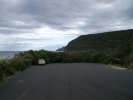

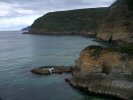
The next stop was the Tasmanian Devil Park to see at least some Tasmanian Devils in Tasmania. (Which turned out to be a good idea, since I didn't get to see any in the wild.) While the cartoon Tasmanian Devil doesn't seem to be overly popular in Tasmania, at least they can't complain about it being misrepresented. It has a voracious appetite, eats almost anything as long as it's meat and is continuously bad tempered. They seem like dogs with short memories, fighting out their pecking order. In one compound there were some devils roaming around. One was walking along the wall, meeting another devil. After some snarling and fighting it ran away, following the wall until it met the same devil again. Another round of snarling and fighting, until it ran away, trotted along the wall, (seemingly) to its surprise, encountered the same devil again and repeated the performance. After that, walked only halfway down the length of the wall and lay down. A bit later the other devil got up and started checking out its territory, noticed the devil lying near the wall, and started a fight. That devil ran away along the wall, while the other one went back to its original place, only to encounter the devil it had chased away coming along the wall from the other side... They seemed to be able to keep that up all day and probably do.
More interesting than the "Tasmanian Devil feeding" was the presentation of birds of prey. (The "Tasmanian Devil Park" is a bit of a mixture of a wildlife park and an nursery for injured birds.) I developed a certain fondness for the "Tawny Frogmouth" (which I had already seen in the wildlife park near Sydney, but didn't know much about). Beside looking a bit scruffy, it also lives up to the second part of it's name. While you expect it to just open its beak for feeding, like other birds do, they can open their mouth quite a bit wider than you'd expect so that it really looks more like a frogmouth than that of a bird. Another thing I had never seen before was a demonstration with one of the raptors (I think it was some sort of small falcon, but I'm not sure) and a piece of meat some meters away. The presenter had the bird perched on his arm and was moving it around and all the time the head of the bird remained at the same position in space as if nailed there. Looked a bit like a rather obscure mime performance. The explanation was this: If a human would sit, for example, on a swaying branch and tried to focus on a specific object, the visual system of the brain would take care of 'removing the motion' from the image the eyes are sending and make the view seem stable. But this 'image processing' requires a fairly large brain. A bird of prey on a moving branch does just compensate for the branch movement using its muscles, 'moving the body around its head' and keeping the head in a steady position. Takes a bit of balancing, but removes the need for 'image post-processing'. I wonder whether you could build a steadycam using birds of prey...
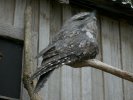
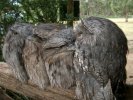

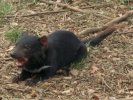
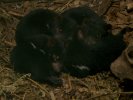
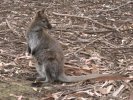
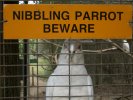
From the "Tasmanian Devil Park" drove on to Freycinet National Park, where I arrived just at sunset.
